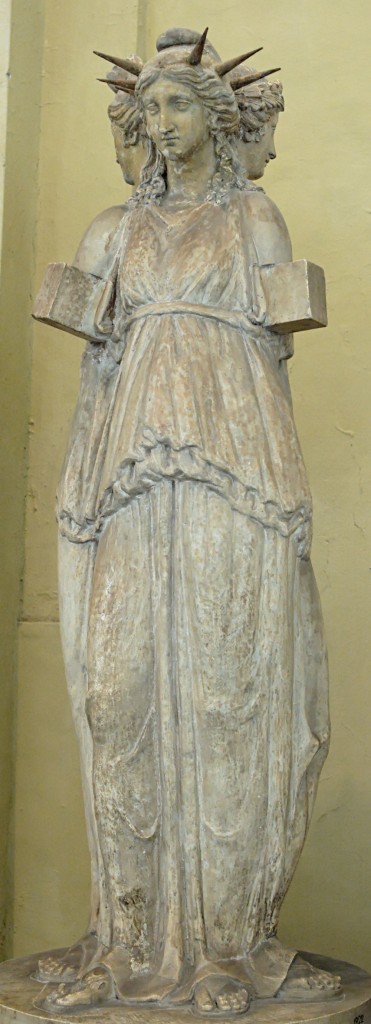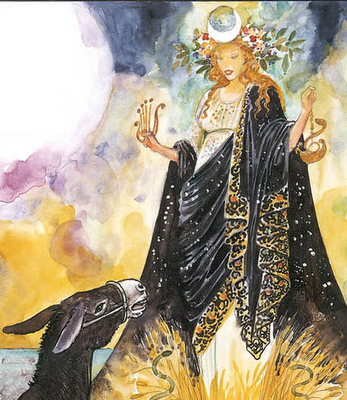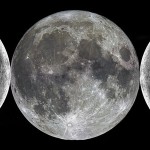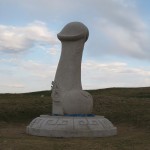The origin of Robert Graves’ Triple Goddess has been hidden from us, because the text on which Graves most likely relied was never translated into English … until now.
Previously, in Part 1, I argued that Robert Graves Triple Goddess is a unique creation: a triunity, as opposed to a triplicity (like the Celtic Matres) or a triad (like the three Brigids). Graves’s Triple Goddess is Three-in-One — resembling the Christian Trinity — a living process, manifest in the phases of the moon, the seasons, and the female life cycle (maiden, mother, crone):
“As Goddess of the Underworld she was concerned with Birth, Procreation and Death. As Goddess of the Earth she was concerned with the three season of Spring, Summer and Winter: she animated trees and plants and ruled all living creatures. As Goddess of the Sky she was the Moon, in her three phases of New Moon, Full Moon, and Waning Moon. … As the New Moon or Spring she was a girl; as the Full Moon or Summer she was woman; as the Old Moon or Winter she was hag.” (The White Goddess, 1948)
In this part, Part 2, I will trace the evolution of the Greco-Roman triple goddess par excellence: Hekate-Diana. Many Pagans will be familiar with the Hekate (or Hecate) as a “triple goddess”, but she did not start out that way. The Greek goddess Hekate begins as a singular Great Goddess of heaven, earth, and sea in Hesiod. She then becomes a goddess of witchcraft and crossroads, and is syncretized with the Roman goddess Diana between the Hellenistic and Early Imperial periods. Finally, in Apulieus’ Golden Ass, Hekate-Diana becomes again a Great Goddess, syncretized with many others goddess, but still not yet recognizable as a truly triune Triple Goddess. Along the way, she takes the form of “triplicities” and “triads”, but only hints at a true triunity.
In the next part, Part 3, I will reveal the previously untranslated text on which Graves likely relied to create his triune Triple Goddess.
The Greek Hekate
Early on, around the 8th century BCE, Hekate appears in Hesiod’s Theogony as a singular Great Goddess of the three realms: heaven, sea, and earth. Her power arguably exceeds that of Zeus, who divides the realms with his brothers, Neptune and Hades. There is also, in Hesiod’s description of Hekate, a suggestion of Goerges Dumezil’s trifunction goddess of sovereignty: she sits by kings in judgement (1st function, legal), she gives victory and glory in battle (2nd function, war), and she gives fishermen good catch, herdsmen increase of stock, and is nurse of the young (3rd function, fertility). Notably absent in Hesiod’s account is any association of Hekate with the underworld or crossroads or witchcraft, which are Hekate’s predominate features in later texts.
In the Orphic Hymn to Hekate, the goddess is again assigned power in three realms: heaven, underworld, and sea. While the hymn contains the epithets, Maiden and Bride (Nymphe), as well as “Sepulchral One”, there is no suggestion of a special trinity. These epithets are mingled among many others.
In the Homeric Hymn to Demeter, which dates to the 7th century BCE, Hekate appears as a kind of psychopomp figure, together with the goddesses Demeter and Kore. These three have been interpreted as crone, mother, and maid respectively — and not without reason. Demeter’s motherhood is evident from her role in the myth and her name (meter = “mother”). Likewise, Kore is maiden, by virtue of her function and her name, which means “maiden”. When Kore becomes Persephone, she can be seen to reflect the crone archetype in her function as Queen of the Dead. Hekate also appears in the myth briefly and could also represent the crone archetype. But in any case, while there are three goddesses, a triad, there is no indication that the they represented aspects of one another, no indication that they form a triunity. The aspects of the Triple Goddess are present, but not the unifying persona. And while the stages of the female life-cycle are represented, there is no association with the moon or the seasons.

It was not until the 5th century BCE, that Hekate appears in a triple form. According to Pausinias, around this time, the sculptor Alkamenes first represented Hekate as three figures arranged around a central column. The figures are more or less identical, forming a triplicity, bit not a triunity. It is unclear how this motif developed, but it is possibly because of her image at 3-way crossroads. Sophocles writes, in his Root-Gatherers, that Hekate Enodia (“of the roads”) “inhabits the sacred crossroads”. Previously, Hekate had appeared only as a goddess seated on a throne or as a guide or psychopomp holding torches. What is clear is that Hekate’s triple form did not initially arise because of any association with the moon.
By the 3rd century BCE, Hekate is associated with (evil) witchcraft, as is evident in Theocritus’ Iylls, Lycophron’s Alexandra, and Apollonius of Rhodes’ Argonautica. She is frequently invoked in stories about the infamous witch Medea. Apollonius gives this spine-chilling account of the epiphany of the goddess:
“And when he had called on her he drew back … the dread goddess, from the uttermost depths came to the sacrifice of Aeson’s son, and round her horrible serpents twined themselves among the oak boughs, and there was a gleam of countless torches, and sharply howled around her the hounds of hell. All the meadows trembled at her step, and the nymphs that haunt the marsh and the river shrieked …”
The Roman Trivia-Diana
Hekate’s association with the moon does not become commonplace until the Roman period, around the turn of the millennium, well after she is given a triple form. This is due perhaps to the greater honor given the moon by the Romans as compared to the Greeks. Interestingly, Varro and Plutarch both state that her image is triple, not because the moon has three faces, but because the moon moves in three ways in relation to the zodiac (although this is probably a post-hoc rationale).
The early Roman author, Catullus, writing in the 1st century BCE, equates Diana with Trivia (“of the three ways”), the Roman name for Hekate, as well as Lucina (goddess of childbirth) and Luna (the moon), but he does not tie the different goddess to the different faces of the moon. The association of these four goddesses with each other became commonplace from this period on.
Diana is frequently syncretized by Roman authors with Trivia-Hekate as a goddess of witchcraft. She is called Trimformis (“having three forms”) by numerous Roman authors, including Horace, Seneca the Younger, and Ovid. A priestess in Virgil’s Aeneid invokes “triple Hekate and the three faces of virgin Diana”. But still these authors do not identify three aspects of the goddess, only three faces, which may have been identical, as they were in Alkamenes’ sculpture.
The next three authors imply that the “faces” of Trivia-Diana have different aspects, but none of them gives a complete description of what those aspects are. Statius’ Thebaid, written in the 1st century CE, identifies Diana as the moon and describes her as having a threefold aspect: “thou dost vary in threefold wise the aspect of thy godhead, and in different shape comest down into the woodland”. Seneca the Younger’s Medea associates Trivia-Diana with the moon and describes her having multiple aspects, but unfortunately only two aspects are mentioned, one radiant and one ghastly:
“I see Trivia’s swift gliding car, not as when, radiant, with full face, she drives the livelong night, but as when, ghastly, with mournful aspect, harried by Thessalian threats [an allusion to witches “drawing down” the moon], she skirts with nearer rein the edge of heaven. So do thou wanly shed form thy torch a gloomy light through air; terrify the peoples with new dread, and let precious Corinthian bronzes resound, Dictynna [an epithet of Diana], to thy aid.”
We get a similarly tantalizing suggestion from Lucan’s Pharsalia or De Bello Civili, which calls Persephone “the last form of Hekate”, suggesting that Persephone is one aspect of the Hekate, but he does not state what the other aspects are. Later, Lucan (like Seneca) states that Hekate has two forms, one “comely” which she shows to the gods and another “wasted and pallid” when she is in hell. But rather than representing different phases of the moon, these aspects seem to be describing the different hues of the moon as it appears close to the horizon and high in the sky.
Apulieus’ Triple Goddess
 In the late 2nd century CE, Lucius Apuleius wrote his Metamorphoses or The Golden Ass, which was to have a profound influence on Robert Graves. The Golden Ass is about a man who is magically transformed into an ass and then is initiated into the mysteries of Isis. Near the end of the novel, the protagonist prays to Great Goddess Isis to be restored to his human form and she appears to him. You can read an English translation of the text here.
In the late 2nd century CE, Lucius Apuleius wrote his Metamorphoses or The Golden Ass, which was to have a profound influence on Robert Graves. The Golden Ass is about a man who is magically transformed into an ass and then is initiated into the mysteries of Isis. Near the end of the novel, the protagonist prays to Great Goddess Isis to be restored to his human form and she appears to him. You can read an English translation of the text here.
Apulieus was a master syncretist. He identifies the Great Goddess Isis with Ceres, Venus, Diana, “three-formed Proserpine”, as well as Minerva, Hekate and others. The text identifies goddess associated with the three realms we have been discussing: “celestial” Venus and Diana (heaven), Ceres (earth), and Proserpine-Hekate (underworld). Also present are the archetypal Maid (Kore), Mother (Ceres), Lover (Venus), and Queen of Death (Proserpine), although they are not identified as such. One can also find in the text the three processes which Graves associated with his Triple Goddess: the seasons (Ceres and Kore), the human life-cycle of birth, procreation and death (Diana, Venus and Proserpine), and the phases of the Moon (Diana). But again, Apuleius does not draw these connection explicitly.
Robert Graves quotes this text in The White Goddess. And two years after its publication, Graves published his own translation of Apuleius. The similarity of Apulieus’ text to Graves’ White Goddess is unavoidable. Graves puts the following words into the mouth of his Muse:
“I am the Triple Mother of Life, the mistress of all elements, the original Being, the Sovereign of Light and Darkness, the Queen of the Dead, to whom no God is not subject. I rule the starry skies, the boisterous green seas, the many-coloured earth with all its peoples, the dark subterrene caves.” (emphasis added)
Compare Apulieus’ text:
“I am she that is the natural mother of all things, mistress and governess of all the Elements, the initiall progeny of worlds, chief of powers divine, Queen of heaven! the principal of the Gods celestial, the light of the goddesses: At my will the planets of the sky, the wholesome winds of the seas, the lamentable silence of hell be disposed; my name, my divinity is adored throughout the world, in divers manners, in variable customs, and by many names.” (emphasis added)
Graves then goes on to list the many names of the White Goddess in the same fashion as Apuleius’ Isis in The Golden Ass.
Apuleius’ influence on Graves cannot be overstated. And Apulieus does give us all of the elements of Graves’ Triple Goddess, but he does not systematize these multiple and varied associations, which are jumbled together in The Golden Ass in a barely comprehensible fashion. There is no explicit association of the multiple forms of Apuleius’ Great Goddess to the phases of the moon, the seasons, or the stages of the female life-cycle. For this, we will have to look to another Roman author, who was the real inspiration behind Robert Graves’ Triple Goddess, which will be the subject of Part 3.
















